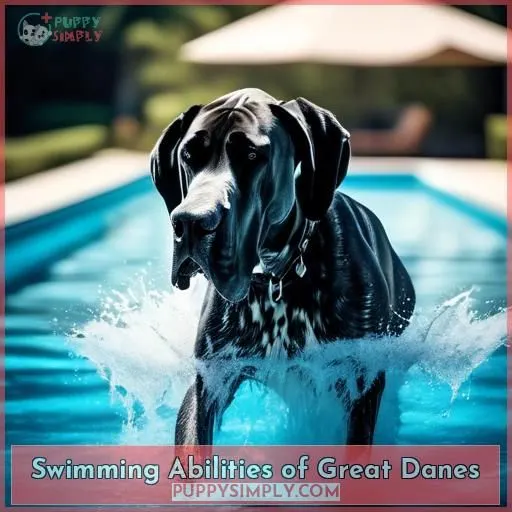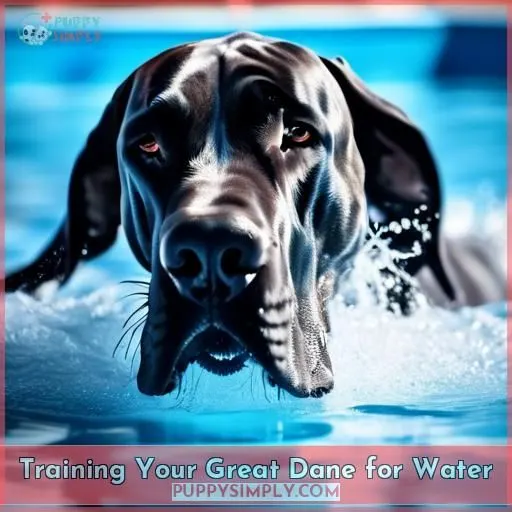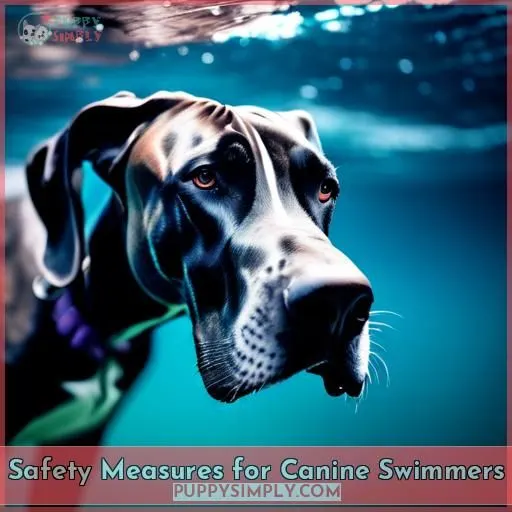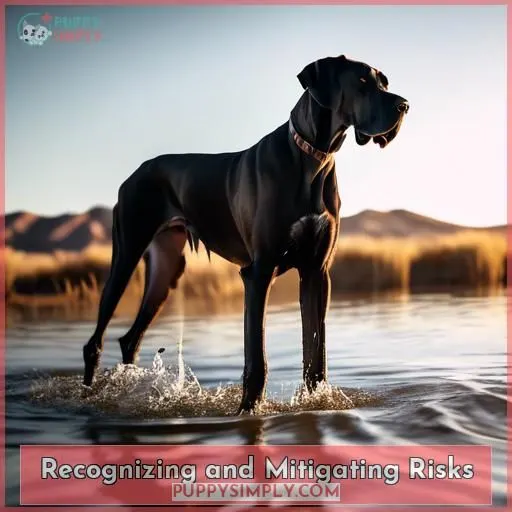This site is supported by our readers. We may earn a commission, at no cost to you, if you purchase through links.
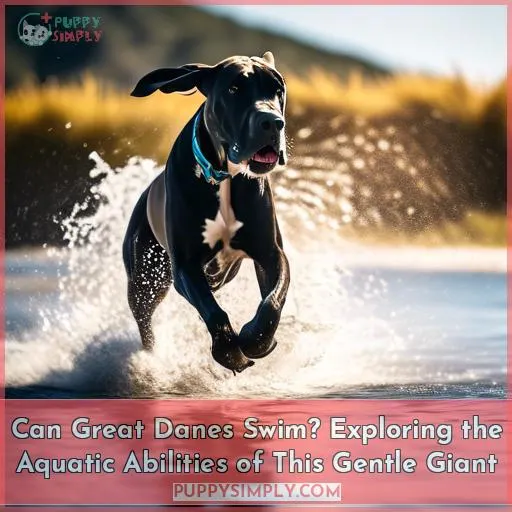
While Great Danes possess physical traits that may aid swimming, such as a muscular build and webbed feet, their natural inclination varies.
You’ll need proper training, employing positive reinforcement techniques and gradual water exposure, to make sure your Great Dane feels comfortable and confident in the water.
Supervision and safety measures like life jackets are essential when allowing your Dane to swim, as they can experience distress or disorientation.
Don’t underestimate the importance of patience and consistency when introducing your gentle giant to swimming; they may surprise you with their aquatic abilities if approached correctly.
Table Of Contents
- Key Takeaways
- Can Great Danes Swim?
- Can Great Danes Swim?
- Swimming Abilities of Great Danes
- Physical Build and Swimming Proficiency
- Training Your Great Dane for Water
- Safety Measures for Canine Swimmers
- Recognizing and Mitigating Risks
- Individual Experiences With Water
- Suja’s Insights on Danes and Water
- General Swimming Advice for Danes
- Pool Considerations for Great Danes
- Frequently Asked Questions (FAQs)
- Conclusion
Key Takeaways
- Great Danes have the physical traits, such as a muscular build, long legs, and webbed feet, that can aid their swimming abilities, but not all Great Danes are natural swimmers and their comfort and proficiency in water can vary.
- Proper training using positive reinforcement techniques and gradual exposure to water are essential to help Great Danes become comfortable and confident swimmers.
- Safety measures, including the use of life jackets and constant supervision, are crucial to preventing drowning, hypothermia, and other risks associated with swimming.
- Individual experiences with water can greatly influence a Great Dane’s willingness to swim, highlighting the importance of patience, consistency, and understanding each dog’s unique preferences and fears.
Can Great Danes Swim?
Yes, Great Danes can swim, although they are not natural-born swimmers. With proper training and practice, they can become competent swimmers. Their physical build, including long necks and snouts, helps them keep their head above the surface while floating, and their muscular upper body provides the energy needed to swim. However, it is essential to introduce them to water gradually and ensure their safety while swimming, as they may tire quickly and need assistance if they become distressed.
Can Great Danes Swim?
Great Danes, renowned for their amiable nature and imposing stature, possess the ability to swim.
Nonetheless, their aquatic prowess varies between individuals; some exhibit greater enthusiasm and comfort in water than others.
Swimming offers Great Danes a delightful and advantageous pastime, fostering physical activity and water-based enjoyment.
Comprehending their inherent capabilities and behavioral disparities is essential for ensuring their safety and pleasurable experiences.
For those requiring assistance and instruction to heighten their swimming proficiency, swimming lessons prove highly beneficial.
Safety should always be paramount, with life jackets, supervision, and appropriate training employed to minimize hazards such as drowning, hypothermia, and physical harm.
Swimming Abilities of Great Danes
Great Danes’ physical traits, such as their large, muscular build, long legs, and webbed feet, aid in their swimming abilities. However, adequate training and vigilant oversight are vital to guarantee their safety and well-being in the water, as not all Great Danes are innate swimmers or exhibit an inherent affinity for aquatic pursuits.
Physical Traits Aiding Swimming
Great Danes can indeed swim, but not all are natural swimmers**. Their physical traits, such as long legs, webbed feet, and a thin frame, can aid their swimming abilities. However, it’s essential to introduce them to water gradually and provide adequate supervision for safety. Training and positive reinforcement can help them become more relaxed and confident in the water.
Training and Supervision Importance
As a conscientious dog owner, it’s essential to safeguard your Great Dane’s well-being while they’re swimming. Here are some key aspects to ponder:
-
Training Approaches: Begin with encouragement and patience. Gradually introduce your dog to water, starting with shallow areas and eventually moving to deeper waters. Pay attention to your dog’s disposition and comfort level, as this will affect their swimming capabilities.
-
Oversight: Continuously monitor your Great Dane while they’re swimming. Observe for signs of distress, such as excessive panting, paddling, or difficulty staying afloat. Be prepared to intercede if needed.
-
Safety Measures: Utilize a life jacket or other flotation device to provide additional buoyancy and support. Ensure the water is secure and devoid of hazards, such as rocks or underwater obstacles.
-
Recall Reinforcement: Regularly practice recall commands to assist your dog in promptly returning to safety. This is particularly important in unfamiliar environments where they may be more likely to stray.
-
Swimming Instruction: Contemplate enrolling your dog in swimming lessons with a professional trainer. They can offer guidance on techniques and safety precautions customized to your dog’s needs.
-
Temperature Monitoring: Monitor your dog’s body temperature, especially in cold water, to prevent hypothermia. Thoroughly dry them after swimming to prevent prolonged exposure to wetness.
Physical Build and Swimming Proficiency
The muscular build of Great Danes contributes notably to their swimming prowess, as their robust upper body supports their weight and enables efficient movement in the water. Their long legs, while primarily associated with their impressive stature, also provide vigor for paddling and propulsion, empowering these gentle giants to navigate aquatic environments with relative ease.
Muscular Build and Swimming
Your Great Dane’s muscular build isn’t just for show; it’s a key player in their swimming saga. While their body size offers natural buoyancy aids, don’t throw them in the deep end without novice training.
Can Great Danes swim? Absolutely, with a bit of help.
Long Legs and Paddling Strength
Great Danes’ long legs provide a strength advantage in the water, enabling them to paddle effectively. Their physical traits, such as webbed feet, also contribute to their swimming abilities. However, not all Great Danes are natural swimmers, and training and supervision are essential for their safety.
Training Your Great Dane for Water
Essential reinforcement techniques are vital when training Great Danes for water, as this gentle breed may exhibit initial apprehension or fear. Swimming lessons from qualified professionals can also greatly benefit these Dogs, providing guidance on proper techniques and gradual exposure to water environments.
Positive Reinforcement Techniques
Essential reinforcement is a critical aspect of training your Great Dane for water.
Start by introducing them to water incrementally, using treats or toys as incentives for positive behavior.
Organized training with an emphasis on gradual exposure can assist your dog in becoming more comfortable with swimming.
Breed-specific variations and individual preferences should be taken into account when devising a training program.
Recall, patience and consistency are fundamental to aiding your dog in developing confidence and abilities in the water.
Swimming Lessons Benefits
Swimming lessons can greatly improve your Great Dane’s water comfort and swimming abilities. By acquiring proper techniques and safety measures, your dog can become a self-assured and competent swimmer. Here are four advantages of enrolling your dog in swimming lessons:
- Improved water confidence: Lessons assist dogs in overcoming fear and hesitation, making them more comfortable in and around water.
- Enhanced swimming techniques: Trainers guide dogs on how to paddle, float, and navigate diverse water environments.
- Strengthened muscles: Swimming lessons promote physical fitness and muscle development, which can benefit your dog’s overall health.
- Safer swimming experiences: Trainers guarantee that dogs learn crucial safety skills, such as entering and exiting pools and avoiding risks.
Safety Measures for Canine Swimmers
You should always use a properly fitted life jacket when taking your Great Dane swimming to provide buoyancy and prevent accidental drowning. Constant surveillance is essential, as even strong swimmers can experience difficulties or become disoriented in the water.
Life Jackets for Buoyancy
Life jackets are essential for safeguarding your Great Dane’s well-being while swimming.
Engineered with floatation aids and materials, these jackets assist your dog in floating comfortably and securely in the water.
When choosing a life jacket, take into account the dog’s size, weight, and girth, along with the intended purpose, such as swimming or as a safety measure.
Well-known brands include Ruffwear, Ezydog, and Paws Aboard, which provide a variety of sizes and features.
Always ensure a proper fit to prevent the dog from getting a paw trapped inside the jacket.
Supervision to Prevent Accidents
Regarding water safety, consider supervised swimming as your Great Dane’s designated protector during swimming sessions. Buoyancy aids act as their water wings, boosting their confidence to paddle without apprehension. Maintaining a vigilant watch guarantees accident prevention, transforming potential mishaps into mere splashes in the pond. Remember, a watchful owner is the cornerstone of safely unlocking their aquatic freedom.
Recognizing and Mitigating Risks
While Great Danes can be strong swimmers, you must take precautions to prevent drowning by introducing them gradually to water, using life jackets, and maintaining close supervision. Additionally, be aware of the risks of hypothermia, especially in colder waters; monitor their body temperature closely and dry them thoroughly after swimming sessions.
Drowning Prevention Strategies
Essential Drowning Prevention Measures for Great Danes
1. Life Jackets:
Always equip your Great Dane with a life jacket or vest when swimming, especially if they aren’t proficient swimmers. These devices provide buoyancy and aid in preventing incidents.
2. Swimming Education:
Instruct your dog in correct swimming techniques, such as doggy paddling, to enhance their buoyancy and prevent drowning. This can be achieved through formal swimming lessons or supervised practice in a controlled environment.
3. Cold Water Awareness:
Monitor the water temperature and refrain from swimming in cold water, as it may induce hypothermia. Symptoms of hypothermia include trembling, sluggishness, rigid muscles, pale gums, and decreased heart and respiratory rates.
4. Environmental Risks:
Be vigilant of potential hazards in the water, such as rocks, submerged debris, and strong currents. Supervise your dog closely during swimming to guarantee their well-being.
5. Constant Supervision:
Never leave your Great Dane unattended near water, as drowning can occur swiftly and discreetly.
Hypothermia Awareness and Care
Hypothermia is a severe condition that can impact your pet, especially when exposed to cold temperatures. It occurs when your pet’s body temperature drops critically low, leading to various health issues, including heart and respiratory system failure. As a responsible pet owner, it’s essential to comprehend the signs of hypothermia and implement the necessary precautions to prevent it.
Recognizing the Signs
The first step in preventing hypothermia is to be aware of the signs. These include:
- Shivering, a natural response to help the body warm up, but may cease entirely once the pet becomes severely cold.
- Drowsiness, confusion, and clumsiness, which can indicate that the pet is struggling to maintain its body temperature.
- Pale gums, which may indicate that the pet isn’t receiving enough oxygen.
- Loss of consciousness or collapse, which is a severe sign of hypothermia.
Prevention and Care
To prevent hypothermia, it’s critical to monitor your pet’s body temperature and take action if you suspect they’re becoming too cold. Here are some steps you can take:
- Monitoring: Keep a watchful eye on your pet’s body temperature, especially when they’re in cold environments or after swimming.
- Drying: Dry your pet thoroughly after they’ve been in the water or exposed to wet conditions, as wet fur can increase the risk of hypothermia.
- Warming: If your pet is showing signs of hypothermia, wrap them in warm blankets and gradually warm them up, avoiding direct heat sources that could burn them.
- Seek Professional Help: If your pet is experiencing severe symptoms of hypothermia, such as loss of consciousness or collapse, seek immediate veterinary attention.
Individual Experiences With Water
Pan, the Great Dane, displayed a wary approach towards water. She only ventured into it when motivated by the presence of geese, relying on her exceptional recall training to return safely ashore.
In contrast, Khan, the other Great Dane, exhibited a more reflexive response. He accidentally entered the water while chasing geese but promptly retreated without attempting to swim.
Pan’s Cautious Water Approach
Pan’s swimming reluctance isn’t set in stone.
Despite being fearful of water, with the right nudge—like chasing geese—she’ll dip her toes in.
It’s about finding that sweet spot between caution and curiosity.
If negative water experiences have left a sour taste, don’t fret.
There’s a whole pool of alternative water activities to explore, ensuring a splash of fun without the pressure.
Khan’s Reaction to Water Stimuli
Khan, a Great Dane, had an initial reaction to water that wasn’t typical of his breed.
He jumped at geese in the water without realizing they were in water, and immediately came back ashore.
This suggests that while Khan could swim, he wasn’t particularly comfortable or familiar with the water at that time.
As a responsible dog owner, it’s essential to provide a safe exit point and teach your Great Dane where the exit is.
Additionally, always supervise your dog while swimming to prevent accidents.
Suja’s Insights on Danes and Water
According to Suja’s insights, exposing Great Danes to water from an early age is paramount, as these gentle giants may exhibit an aversion to aquatic environments. While their physical attributes can aid in swimming, understanding and respecting their potential discomfort around water is essential for responsible pet ownership.
Importance of Positive Water Exposure
To guarantee your Great Dane becomes a confident and safe swimmer, it’s imperative to introduce them to water incrementally and positively.
Commence with a gentle acclimation process.
Utilize positive reinforcement techniques to foster their confidence.
Gradual integration is paramount, as it permits them to become comfortable with the water at their own pace.
Always prioritize safety first.
Provide a secure environment for them to learn and grow.
Understanding Danes’ Water Aversion
Great Danes, like any breed, can develop water phobia due to breed differences, personality traits, or lack of proper socialization.
Suja’s insights reveal that understanding Danes’ water aversion is key to helping them overcome their fear.
By addressing their individual experiences with water, we can reduce their anxiety and encourage positive associations with aquatic environments.
Breed-specific training and socialization can also play a significant role in fostering a healthy relationship with water.
General Swimming Advice for Danes
While Great Danes have the physical abilities for swimming, building a positive connection and teaching them proper technique through motivation and encouragement is essential for developing their confidence in the water. Including recall training during water activities not just improves safety but also strengthens the human-canine relationship, allowing your gentle giant to enjoy aquatic adventures without fear.
Motivation and Encouragement
Diving into the realm of water safety with your Great Dane might seem like a Herculean task, especially if they’re exhibiting a bit of water aversion.
But fear not!
With a sprinkle of swimming motivation and a dash of positive reinforcement, you’ll turn that hesitation into exhilaration.
Recall Training for Safety
Recall training is essential for guaranteeing the safety of your Great Dane in and around the pool.
This skill is vital to prevent accidents caused by your dog’s curiosity or lack of understanding about pool hazards.
It’s important to introduce your dog to the pool gradually and observe their comfort level.
Regular training sessions will help your dog associate the pool with positive experiences.
Additionally, consider the quality of the water, frequency of swimming, and duration of training to ensure your dog’s health and well-being.
Pool Considerations for Great Danes
An above-ground pool requires particular attention for Great Danes’ well-being, such as providing an easily reachable exit point and training them on its whereabouts to prevent possible harm from jumping out. Adequate maintenance is essential, involving regular cleaning, chemical balancing, and timely leak repairs to guarantee a safe and enjoyable swimming experience for your gentle giants.
Above-Ground Pool Safety
Great Danes can swim, but their swimming abilities vary. While some may be natural swimmers, others may need assistance or training. Physical traits like long legs, webbed feet, and a thin frame can aid swimming, but training and supervision are essential for safety. Not all dogs enjoy swimming or are capable of it. Life jackets are recommended for their protection.
When it comes to above-ground pools, Danes may be wary due to their size. Provide a safe exit point and teach them where it is. Danes aren’t likely to tear pools, but jumping out of pools onto the ground can be dangerous.
Pool maintenance is vital. Regularly clean the pool after use to remove debris introduced by dogs. Keep water chemistry balanced to avoid contamination. Pool covers can help prevent the spread of bacteria.
Pool Maintenance Essentials
Pool maintenance is essential for ensuring your Great Dane’s safety and pleasure in the pool.
Maintain the pool’s cleanliness with regular skimming and vacuuming, monitor water chemistry, and swiftly repair any leaks.
Pool accessories such as covers, filters, and heaters can improve the experience, while pool toys provide entertainment.
Bear in mind, durability is paramount for above-ground pools, but they still require vigilant attention to preserve their integrity.
Frequently Asked Questions (FAQs)
How do Great Danes adapt to swimming?
You’re right to be mindful, friend. Great Danes adapt via their robust build – long legs propel ’em through water while their muscular frame supports swimming movements. With training and safety precautions like life vests, these gentle giants can happily make a splash!
Can Great Danes swim in open water?
You might think open water‘s too challenging, but with training, Great Danes can swim remarkably well. Their muscular build aids paddling, while webbed feet provide propulsion. Just supervise closely and use a doggy life jacket for safety’s sake.
What are the best pools for Great Danes?
For Great Danes, you’ll want a sturdy above-ground pool – think metal-framed, at least 4ft high. Provide an exit, like steps or a low entry point, for their safety. These gentle giants will love cooling off and splashing around in their own backyard oasis!
How can I help my Great Dane overcome water fear?
Picture your Dane paddling happily—introduce water slowly with treats and praise. Use a life vest for security. Stay positive—their fear will fade through repetition in a calm setting.
What are the common swimming mistakes to avoid with Great Danes?
The biggest mistake? Forcing them into the water. Introduce swimming slowly, praise progress, and provide life jackets. Never leave them unsupervised – even great swimmers can struggle and drown without warning.
Conclusion
Akin to Hercules’ trials, your journey with your Great Dane’s swimming prowess requires perseverance.
Armed with positive reinforcement, patience, and vigilant safety measures, you can confidently guide your gentle giant to conquer the waters.
With commitment, your Dane can potentially flourish in the aquatic domain, showcasing their innate abilities if given the chance to embrace the waves.


